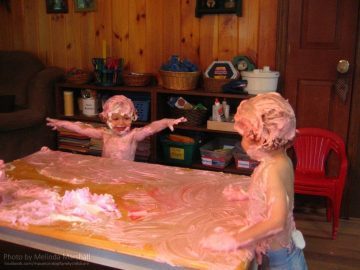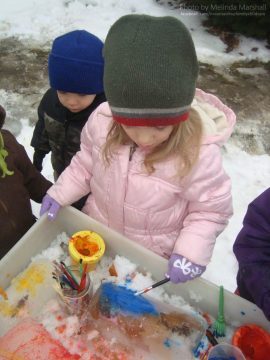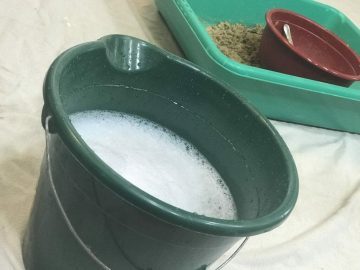Revised | Originally Published: July 4, 2021 @ 1:51 pm

Worries about taming the mess keep many early learning professionals and parents from embracing messy play, and that’s a shame. Messy play has many developmental benefits, from building strong fingers to building effective social skills. Do you shy away from offering such play because you’re distracted by The Mess? You’re not alone; The Mess is a monster often made much bigger and scarier in people’s heads than in real life. Here are some simple tips for Taming The Mess so you can be more supportive of this valuable type of play:
Manage Your Mindset
Bring a calm, focused, and open mindset to taming The Mess. Kids are exceptionally adept at reading their adult caregiver’s emotional state. They’ll pick up on any stress or anxiety you’re walking around with—even if you think you’re really good at hiding it. Your emotional state can be a distraction for kids and feed their own fears or anxieties. On the other hand, being tuned in sets the stage for success.

Prepare To Clean
Make sure you have post-messy-play cleaning supplies ready to go before the play starts. You don’t want to be stuck hunting for your favorite sponge or scrubby pad followed by a flock of paint-covered toddlers who want you to pick them up. The Mess is easier to defeat when you’re pre-armed for the battle.
(Un)Dress For Mess
In my experience, slipping a paint smock or old shirt on a child before messy play is more work than it’s worth. It adds extra work (putting it on, removing it, cleaning it, and putting it away). Besides, more often than not, removing it from the child often leaves you both covered in The Mess. Smocks and paint shirts are essentially just another layer of mess that needs to be cleaned. Why waste the time and energy? Another thing is that paint smocks/shirts can restrict movement. Purpose-made smocks are often made of easy-to-clean material that’s stiff and restrictive, while DIY paint shirts are frequently many sizes larger than the child wearing them. Both limit a child’s range of motion.

Instead, either strip kids down to the bare essentials (diapers or underwear) and let them play, or make sure they start the play wearing clothing that can get messy and have something to change into (that can also get messy) when they are done. I get that the nearly-naked option won’t fly for some readers and in some settings, but it’s still a great option, especially for infants and toddlers.
Kids are wired to touch the world and engage it with their whole bodies, so it makes sense for them to spend their days in clothing that can get messy (and have plenty of backup clothing). Early learning programs that embrace play should also embrace play-friendly clothing policies.
Manage The Space
One way to make taming The Mess easier is to remove items you don’t want it to envelop from the space before messy play begins. Make the space as mess-friendly as possible. For example, stack all the cute kid-sized chairs in the corner away from the finger painting table and put Nibbles, the class rabbit, in her cage so you won’t have to completely wipe down each chair and bathe the bunny after the paint is put away.
Take It Outside
Bringing the play outside is another step toward taming The Mess. We adults seem to freak out less when messes are made outside. We also relaxed our cleanup standards a bit- a few dried drops of purple paint on a white tile floor are a Bigger Deal than the same drops on the lawn.

Plan For Rinsing
Keep a bucket or tote of warm, soapy water and some towels next to your messy play so kids can easily rinse and dry their hands, feet, and whatever else while playing. This helps keep the mess from spreading. Knowing they can get clean fast also makes messy play a bit easier for some children with sensory issues–they are more likely to engage in The Mess when it’s easy to wash off.

Protect The Floor
Not all play spaces have messy-play-friendly flooring. In such cases, I recommend protecting the floor with fabric drop cloths or, better yet, moving blankets. They are less slippery than plastic drop cloths and reusable, and because they have a bit of heft, they don’t move around as much as plastic options. They are also absorbent, which is a big plus when taming The Mess.
Kids Can Help
It only makes sense that the little humans who create The Mess should play at least some part in the cleanup process. Just make sure to manage your expectations–toddlers are not as capable as ten-year-olds.
Taming The Mess Wrap-Up
One final tip for taming the mess: Simply offering children messy play opportunities using the above tips can help reduce anxiety or wariness about such play. Being around it makes it easier to be around it.
I hope you will take baby steps into creating messy play opportunities; they offer so many learning opportunities. Taming The Mess is possible.
Since you have read this far, you deserve these three helpful links:
Contribute content to Playvolution HQ
Brought to you by Explorations Early Learning
Browse Trainings

Post Author
Jeff Johnson is an early learning trainer, podcaster, and author who founded Explorations Early Learning, Playvolution HQ, and Play Haven.

Leave a Reply